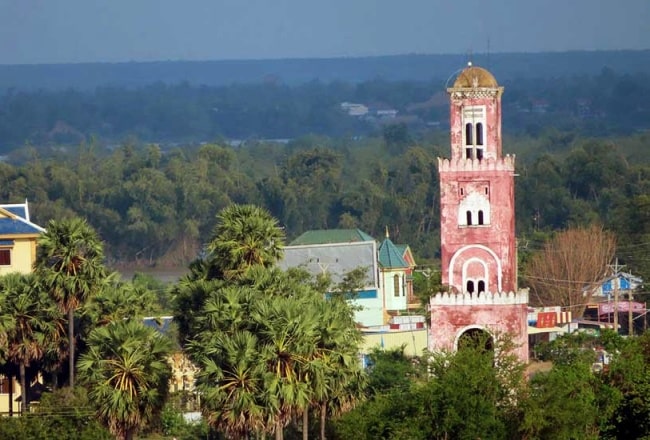One of the most famous sites in Kampong Cham city was previously its bamboo bridge, connecting the mainland to a Mekong River island called Koh Paen. Previously the longest bamboo bridge in the world at 1km long, it could amazingly carry large trucks as well as the numerous cars, motorcycles and bicycles that crossed it every year. Washed away each and every year during monsoon season, the famous bamboo bridge was painstakingly rebuilt every year without fail. A concrete bridge has now replaced this famous bamboo bridge, although a smaller bamboo bridge has been built nearby, which people can cross on foot or by pushing a bicycle over it.

It's worth making the trip over to Koh Paen for the bridge experience as well as to explore one of the Mekong’s islands. Cycle around for the best experience and to discover small villages, island temples and the beach where there are some snack stands selling traditional Khmer flavours too.
On the edge of the city is Wat Nokor, part of the ancient Banteay Prey Nokor temple complex. This is the location where it is believed King Jayavarman VII used as his headquarters for a significant period of time to exert his influence over other local regions. Unlike many other temple complexes in Cambodia, which are usually constructed using brick or red sandstone, Wat Nokor is built from black sandstone. The central tower of the temple depicts a number of scenes from Buddhist teachings.

One of the most iconic sights in Kampong Cham is the French Colonial Watchtower on the banks of the Mekong. It was built in the 1900s to guard the river, as Kampong Cham was an important trading port for the French at this time. It looks magical on the riverbank and reminds visitors of a former era. It’s possible to climb the very steep staircase to catch the views from the top, from which Kampong Cham city and the Kazuna bridge are both visible.

A temple worth visiting outside the city is Wat Maha Leap, as it is one of the only wooden pagodas left in Cambodia. After being used by the Khmer Rouge as a hospital with original adornments covered up, monks have painstakingly restored some of the pagoda’s features to their former glory. Monks still live and pray from a building next to the temple. Another interesting pagoda just outside the city is Wat Hanchey. With origins at least as far back as the 8th century, this hilltop temple also offers fantastic views of the Mekong River and the surrounding area.

Phnom Srey (‘Woman Hill’) and Phnom Pros (‘Man Hill’) are two hills located on the outskirts of Kampong Cham city. Home to temples, statues and pagodas, there are also many local legends that relate to these hills and stories between men and women that the name of the hills originate from. The hills also offer magnificent views over the surrounding countryside.

Kampong Cham Province is well-known for its rubber plantations, and it’s possible to pay a visit to some of them to see how the fascinating process works. One plantation not too far from the city is the Chup Rubber Plantation, where tours for visitors are possible.

For those visiting from Phnom Penh, or for those who want to visit Cambodia’s capital from a base in Kampong Cham, it’s as quick to travel between the two by road as it is by boat along the Mekong River. The latter option offers a wonderfully scenic experience of Mekong life, so take advantage of the opportunity.


























